Fuerteventura is a stunning island that is located in the Canary Islands, Spain. It is known for its white sandy beaches and crystal-clear waters, and the island is loved by many tourists who visit it every year.
Another aspect of Fuerteventura that makes it stand out is its diverse birdlife. The island is home to many unique species of birds, which make it a birdwatcher’s paradise. From large birds of prey like the griffon vulture to the beautiful blue and white Hoopoe, Fuerteventura has a bird species for everyone to enjoy.
This article will delve into some of the bird species found on the beautiful island of Fuerteventura.
1. Houbara Bustard
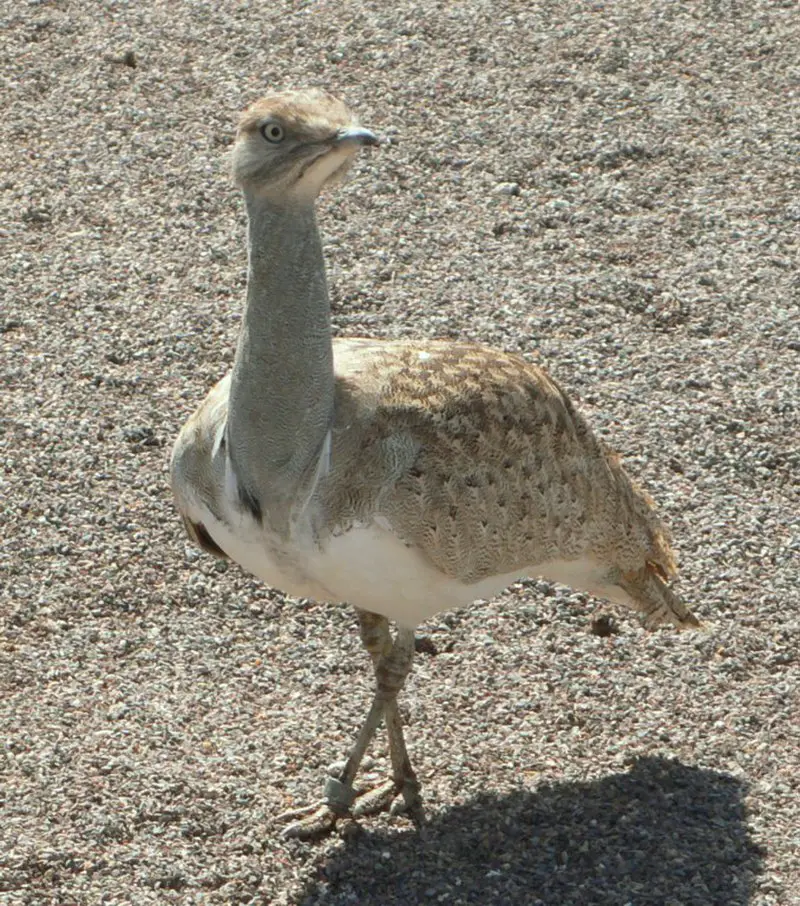
The Houbara Bustard is a small bird native to North Africa. It has dull brown feathers with black markings on the wings, and a grey crown of feathers atop its head.
This species inhabits arid habitats, making it particularly vulnerable in this environment due to lack of resources available.
The global population is listed as Vulnerable by IUCN Red List and there is also a population in the Canary Islands which has been assessed as Near Threatened.
Conservation efforts have been put into place but more needs to be done if we are going to protect these birds from endangerment or extinction.
We must ensure that their habitat remains protected so they can thrive in safety for generations to come.
Scientific classification:
| Kingdom | Animalia |
| Phylum | Chordata |
| Class | Aves |
| Order | Otidiformes |
| Family | Otididae |
| Genus | Chlamydotis |
| Species | C. undulata |
Also Featured In: Native Pakistani Birds, Birds Live in Tunisia
2. Stone-Curlew

Stone-curlews, also known as dikkops or thick-knees, are a family of birds that have adapted to live in tropical and temperate regions throughout the world.
They can be found in Africa, Asia and Australia with two or more species per region. Despite being classified as waders, most prefer dry arid habitats over moist wetlands.
Stone-curlews typically have long legs which help them navigate through their preferred terrain efficiently; some species even stand at an impressive height when standing on those long legs.
Additionally they feature cryptic plumage which helps them blend into their surroundings while hunting for prey such as insects and small mammals like rodents.
These unique bird’s calls are easily recognizable; it has been said that hearing one is similar to listening to someone whistling ‘Keee Weee’.
Scientific classification:
| Kingdom | Animalia |
| Phylum | Chordata |
| Class | Aves |
| Order | Charadriiformes |
| Suborder | Chionidi |
| Family | Burhinidae Mathews, 1912 |
Also Featured In: Beautiful Brazilian Birds, Common Uzbekistan Birds
3. Sanderling
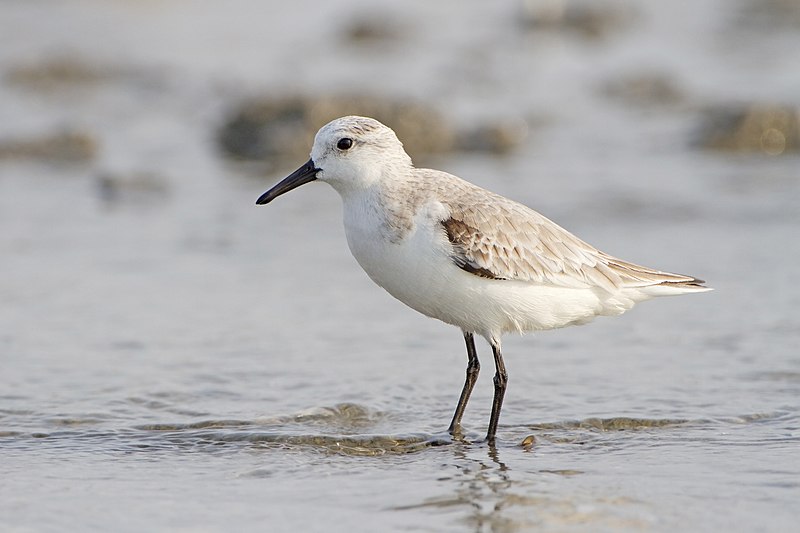
The Sanderling is a small wading bird that can be found in the Arctic region. Its name comes from Old English, meaning “sand-ploughman”. It has grey feathers and light legs which give it its distinct white coloration.
During summer breeding months, they are known to travel great distances – some wintering as far south as South America or Southern Africa. They typically feed on crustaceans such as shrimp and mollusks along coastal shores.
The Sanderling is an important species to watch out for because of their long migratory patterns and sensitivity to environmental change; if there’s trouble with this species then other birds may also be affected.
Scientific classification:
| Kingdom | Animalia |
| Phylum | Chordata |
| Class | Aves |
| Order | Charadriiformes |
| Family | Scolopacidae |
| Genus | Calidris |
| Species | C. alba |
Also Featured In: Top Birds Found in Mexico, Birds You’ll Find in the Sea
4. Eurasian Collared Dove
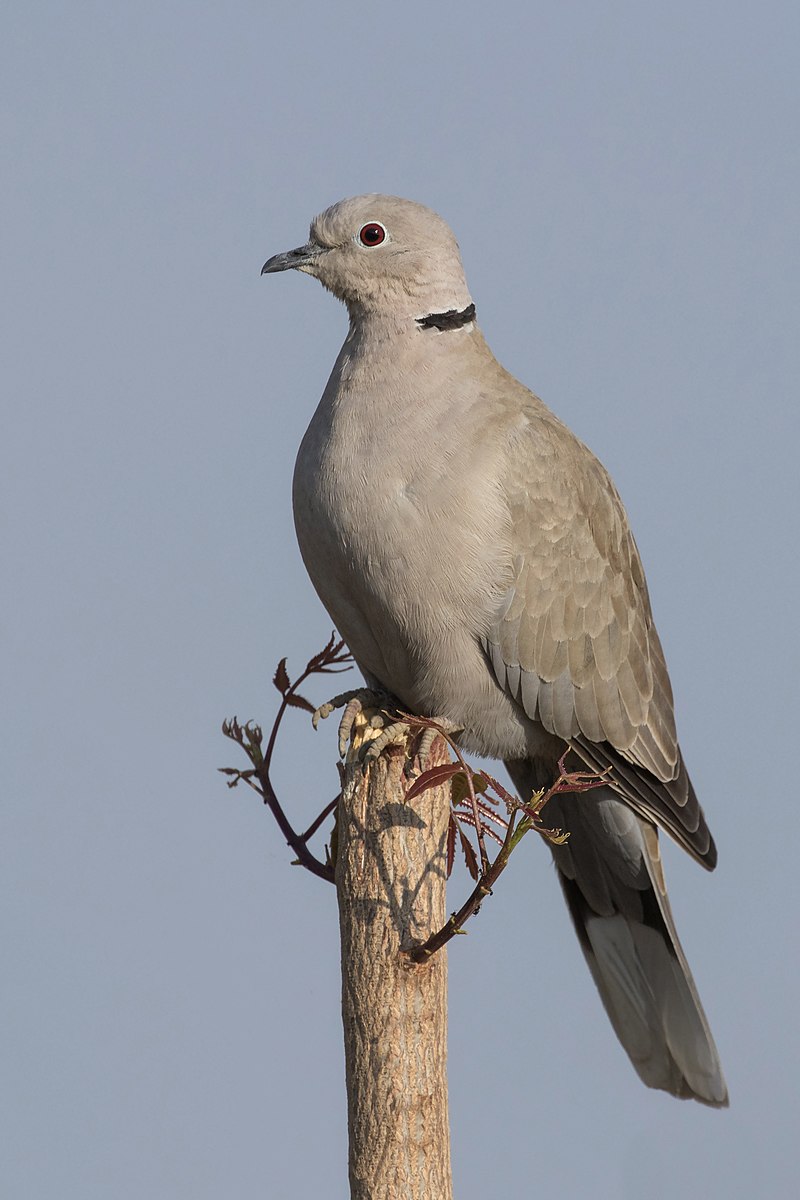
The Eurasian collared dove is a species of bird native to Europe and Asia, with its range expanding through introduction in Japan, North America, and islands in the Caribbean.
It has become so widespread that it is listed as Least Concern on the IUCN Red List. The scientific name for this bird was proposed by Hungarian naturalist Imre Frivaldsz – Columba decaocto.
This beautiful creature typically measures between 33-37 cm from tip to tail feathers, displaying an overall greyish brown plumage; they also have distinctive black half collar around their neck which gives them their common name.
These birds are mainly found inhabiting open woodlands or agricultural lands near human settlements where there’s plenty of food available such as grain fields or gardens where fruits can be eaten off trees.
With a vast global population trend increasing steadily each year these birds make great additions to many backyards throughout the world.
Scientific classification:
| Kingdom | Animalia |
| Phylum | Chordata |
| Class | Aves |
| Order | Columbiformes |
| Family | Columbidae |
| Genus | Streptopelia |
| Species | S. decaocto |
Also Featured In: Turkey Birds You Should Know, Birds That Live in Colorado
5. Egyptian Vulture
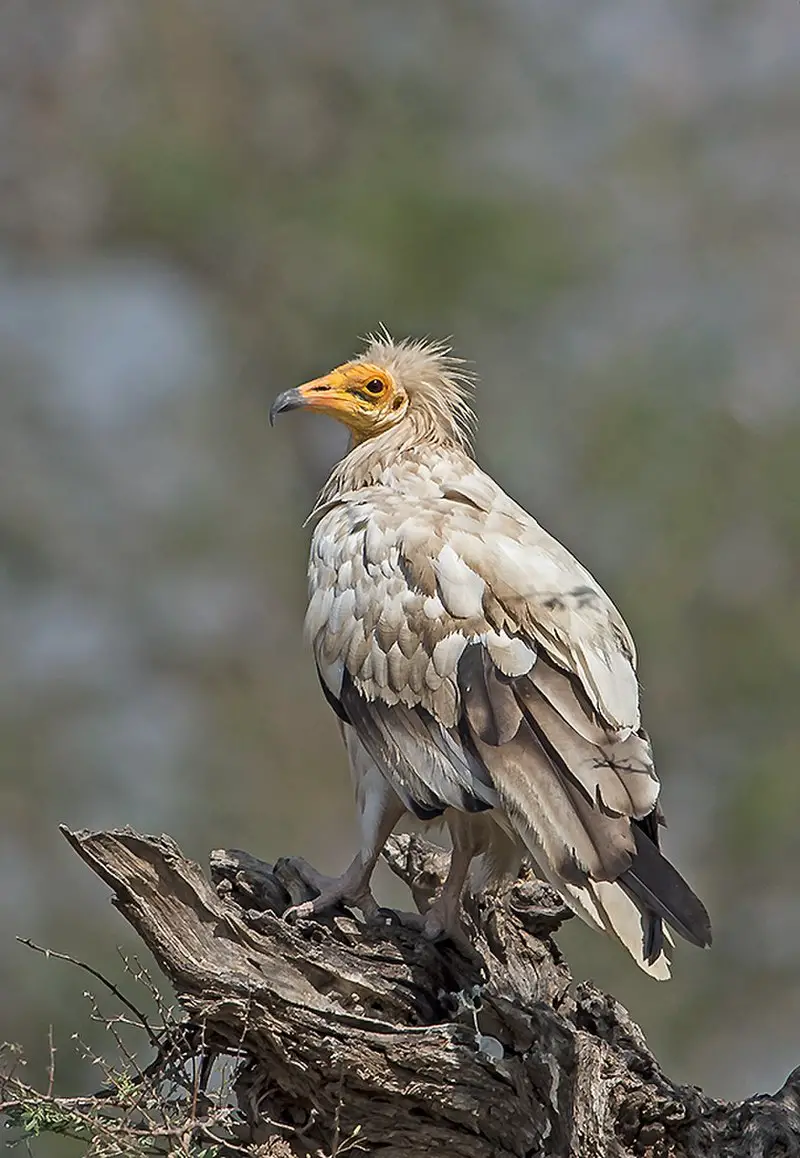
The Egyptian Vulture is a small Old World vulture known for its distinctive wedge-shaped tail and contrasting underwing pattern.
It has been found from the Iberian Peninsula through North Africa to India, making it one of the most widespread birds in that area.
This species eats mostly carrion but will also feed on eggs and small prey if they can find them. Its diet consists mainly of lizards, insects and other invertebrates as well as fruit like figs, grapes or mulberries when available.
The Egyptian Vulture plays an important role in ecosystems by helping to clean up carcasses which could otherwise spread disease or attract predators such as jackals into human settlements.
They are considered vulnerable due to threats including habitat destruction, electrocution from power lines and accidental poisoning – all factors contributing towards their decline in numbers across their range .
Scientific classification:
| Kingdom | Animalia |
| Phylum | Chordata |
| Class | Aves |
| Order | Accipitriformes |
| Family | Accipitridae |
| Genus | Neophron Savigny, 1809 |
| Species | N. percnopterus |
Also Featured In: Egyptian Birds, Birds You’ll Find in Albania
6. Common Greenshank
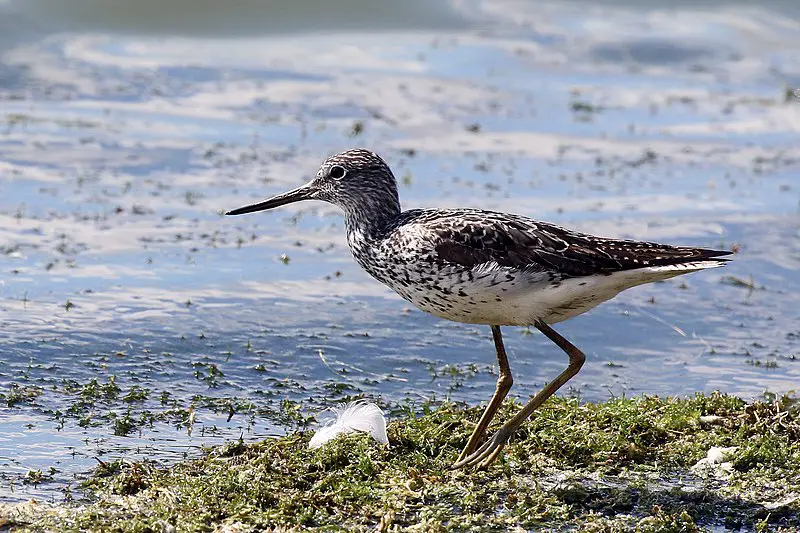
The Common Greenshank is a type of wader, belonging to the large family Scolopacidae. It’s name originates from Aldrovandus in 1599, and references Aristotle’s ancient Greek work which mentions a thrush-sized bird with white rump and tail bobbing.
Its scientific name “nebularia” actually means mist. This small bird can be found near wetlands or marshes throughout Europe and Asia – it has even been spotted as far south as Africa.
They are known for their long legs that allow them to easily traverse shallow water while searching for food like insects, crustaceans, mollusks or worms.
The Common Greenshank is an interesting species whose beauty should not go unnoticed by any nature enthusiast.
Scientific classification:
| Kingdom | Animalia |
| Phylum | Chordata |
| Class | Aves |
| Order | Charadriiformes |
| Family | Scolopacidae |
| Genus | Tringa |
| Species | T. nebularia |
Also Featured In: Common Estonian Birds, Tokyo Birds You Need to Know
7. Common Ringed Plover
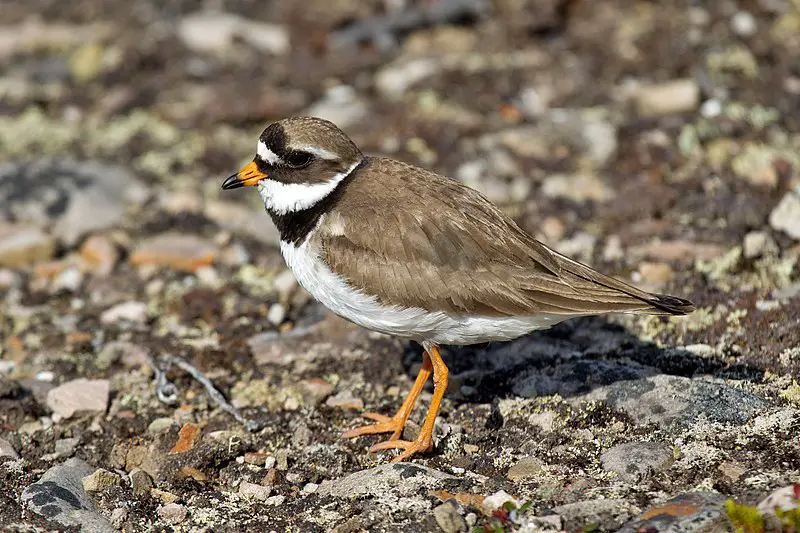
The Common Ringed Plover is a small migratory bird found in Arctic Eurasia. It has yellowish feathers and its Latin name, Charadrius hiaticula, means ‘bird of ravines’.
This species breeds on beaches and tundra during northern summer months before flying south when winter arrives.
Its diet consists mostly of insects which it catches by running along the shoreline or through shallow water with wings spread open to create a shadow that helps catch prey.
The common ringed plover nests in short grasses near water’s edge where they lay two eggs per clutch which hatch within three weeks.
These birds are highly territorial so will often defend their patch fiercely against competitors.
Scientific classification:
| Kingdom | Animalia |
| Phylum | Chordata |
| Class | Aves |
| Order | Charadriiformes |
| Family | Charadriidae |
| Genus | Charadrius |
| Species | C. hiaticula |
Also Featured In: Shetland Islands Birds You Should Know, Birds that Live in Greenland
8. Cattle Egret
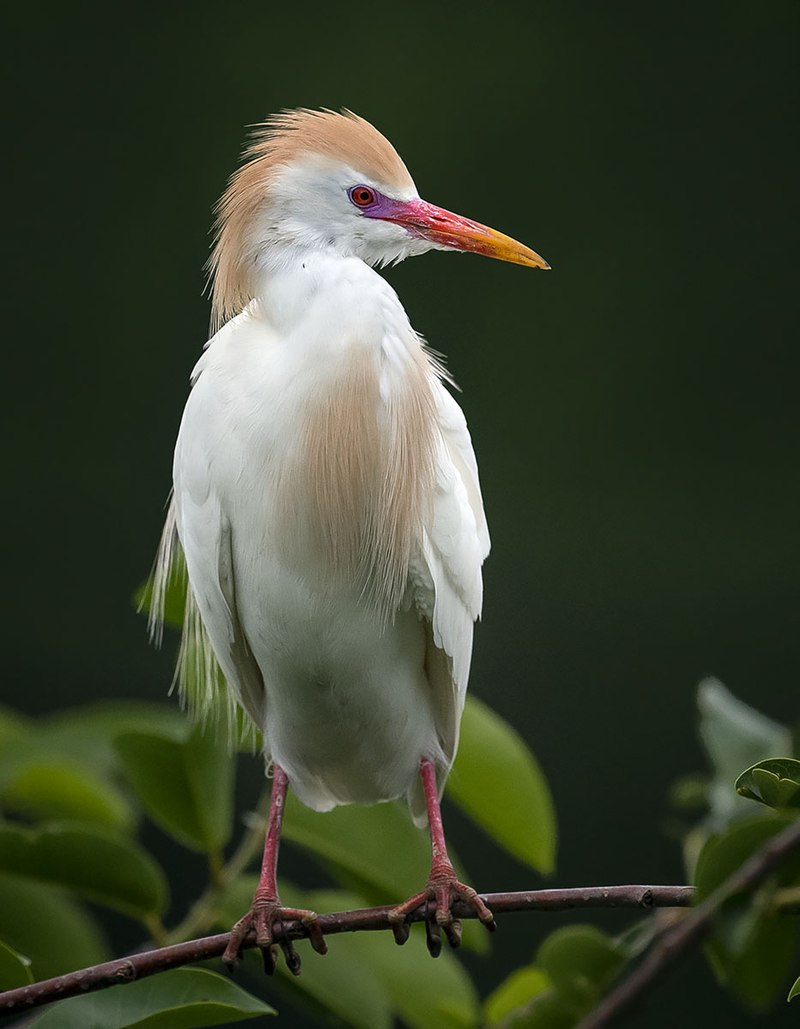
The Cattle Egret is a heron of the family Ardeidae found around the world in tropical, subtropical and warm temperate areas. It has two subspecies: western cattle egret and eastern cattle egret.
They have white plumage with buff plumes on their head, neck and back. The beak is yellowish-orange with black tip while legs are orange or yellow coloured depending on species variation.
This bird usually feeds near large herds of animals such as cows, horses etc., where it finds plenty of insects to eat like grasshoppers, crickets etc..
Its presence benefits these animals by removing ectoparasites from them which leads to healthier livestock population.
It nests colonially in trees or shrubs located close to water bodies during breeding season which generally takes place between March-June every year.
Scientific classification:
| Kingdom | Animalia |
| Phylum | Chordata |
| Class | Aves |
| Order | Pelecaniformes |
| Family | Ardeidae |
| Genus | Bubulcus Bonaparte, 1855 |
| Species | B. ibis |
Also Featured In: Water Birds Live around Us, Asian Birds
9. Cream-Colored Courser
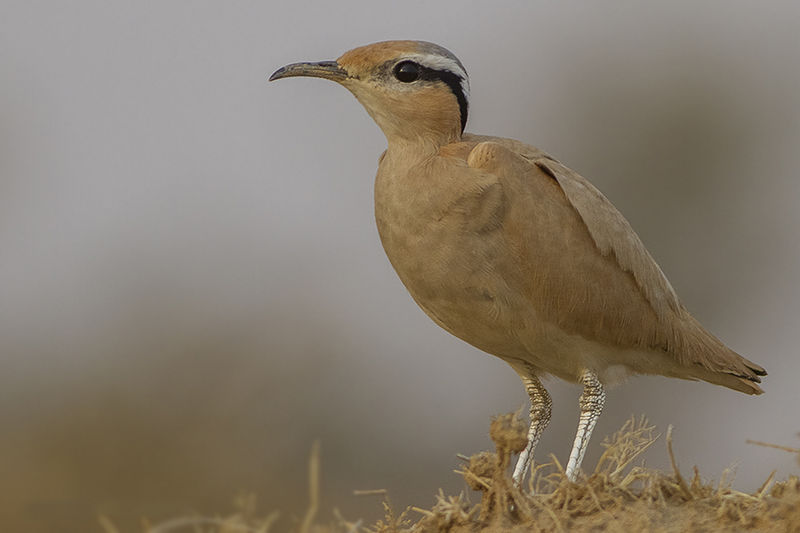
The Cream-colored Courser is a species of wader belonging to the Glareolidae family. It can be found across Western Asia and North Africa and inhabits dry, open semi-desert habitats.
These birds have adapted well to their environment; they are able to run quickly in search of insect prey on the ground which explains their scientific name Cursorius cursor – derived from Latin for ‘runner’.
The coursers also inhabit the Canary Islands as well as Cape Verde where breeding occurs during summer months before migration back south begins in autumn and winter months.
They are easily identified by their distinctive cream coloration with brown streaking along wings, neck and chest region making them an important part of these arid ecosystems.
Scientific classification:
| Kingdom | Animalia |
| Phylum | Chordata |
| Class | Aves |
| Order | Charadriiformes |
| Family | Glareolidae |
| Genus | Cursorius |
| Species | C. cursor |
Also Featured In: Birds That Live in Iraq,
10. Eurasian Spoonbill
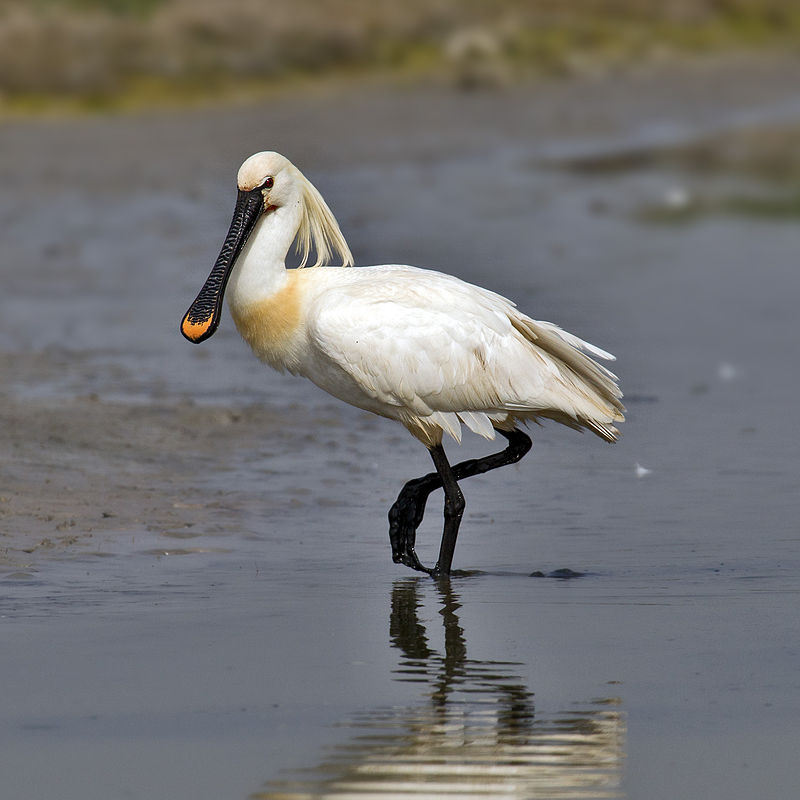
The Eurasian spoonbill is a unique and remarkable wading bird, belonging to the ibis and spoonbill family. It has an unmistakable bill which is broad in shape, giving it its Latin name Platalea “broad”.
Its scientific name ‘leucorodia’ comes from Ancient Greek meaning literally ‘white heron’ due to its predominantly white plumage.
In England this beautiful bird was traditionally known as the ‘shoveler’ because of its distinctive beak.
This rare species can often be found near wetlands or coastal areas where they feed on fish, crustaceans, insects and aquatic invertebrates.
The Eurasian Spoonbill is truly an incredible creature that deserves our protection.
Scientific classification:
| Kingdom | Animalia |
| Phylum | Chordata |
| Class | Aves |
| Order | Pelecaniformes |
| Family | Threskiornithidae |
| Genus | Platalea |
| Species | P. leucorodia |
Also Featured In: Most Common Romanian Birds, Native Birds of Kazakhstan
11. Eurasian Stone-Curlew
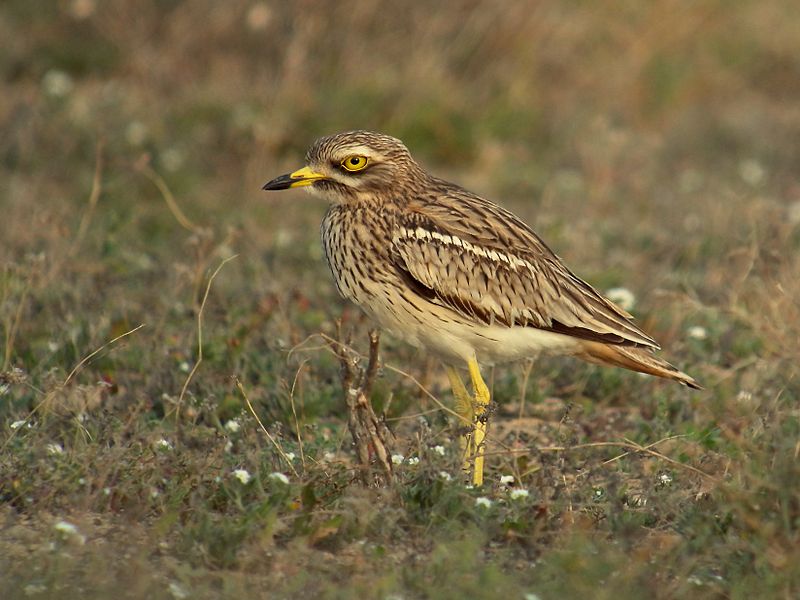
The Eurasian stone-curlew, also known as the Eurasian thick-knee, is a species of bird from the Burhinidae family. It was first described by Swedish naturalist Carl Linnaeus in 1758 and is mainly found in England.
These birds have brown feathers with black markings on their wings and head; they also possess long beaks for catching prey.
They usually feed on insects, small rodents, worms and other invertebrates that can be found near water sources or open areas such as fields and meadows.
Stone curlews are mostly active during night time but can occasionally be seen during day light hours too.
During breeding season these birds make loud calls to attract mates and ward off predators while defending their nests which are often built in grassy plains or dry moorside land away from human activity or disturbance.
Scientific classification:
| Kingdom | Animalia |
| Phylum | Chordata |
| Class | Aves |
| Order | Charadriiformes |
| Family | Burhinidae |
| Genus | Burhinus |
| Species | B. oedicnemus |
Also Featured In: Belarus Birds You Should Know, Birds You’ll Find in Night
12. Eurasian Blue Tit
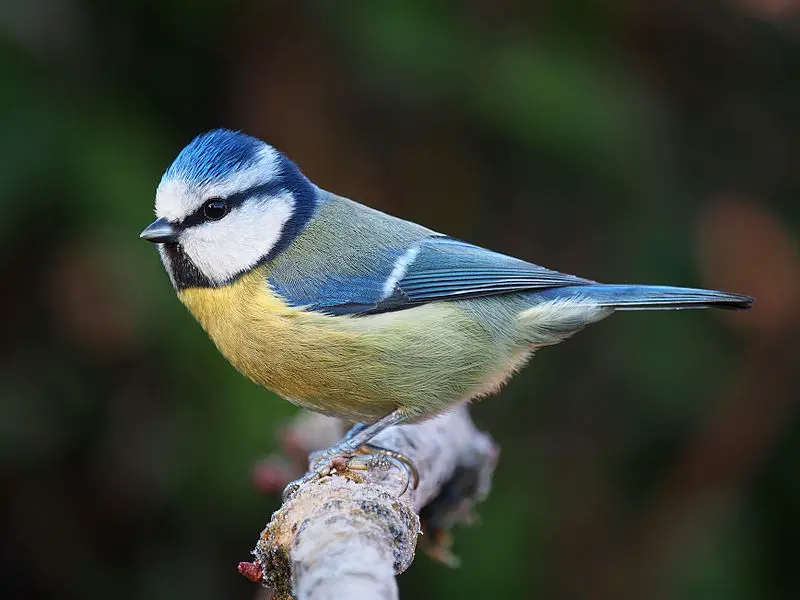
The Eurasian blue tit is a small passerine bird belonging to the Paridae family. Its bright blue and yellow plumage makes it easily recognizable, along with its small size.
They are usually resident birds that do not migrate, living throughout temperate or subarctic Europe and western Palearctic in deciduous woodlands.
These birds breed year-round and are common residents of these areas.
Their diet consists mainly of insects but they also feed on seeds during winter months when insects become scarce.
They can be found both alone or in pairs searching for food amongst trees branches, shrubs, grasses as well as visiting gardens for supplementary food sources such as peanut feeders provided by garden owners.
Scientific classification:
| Kingdom | Animalia |
| Phylum | Chordata |
| Class | Aves |
| Order | Passeriformes |
| Family | Paridae |
| Genus | Cyanistes |
| Species | C. caeruleus |
Also Featured In: Birds of United Kingdom, Famous Paintings Birds
13. Black Redstart
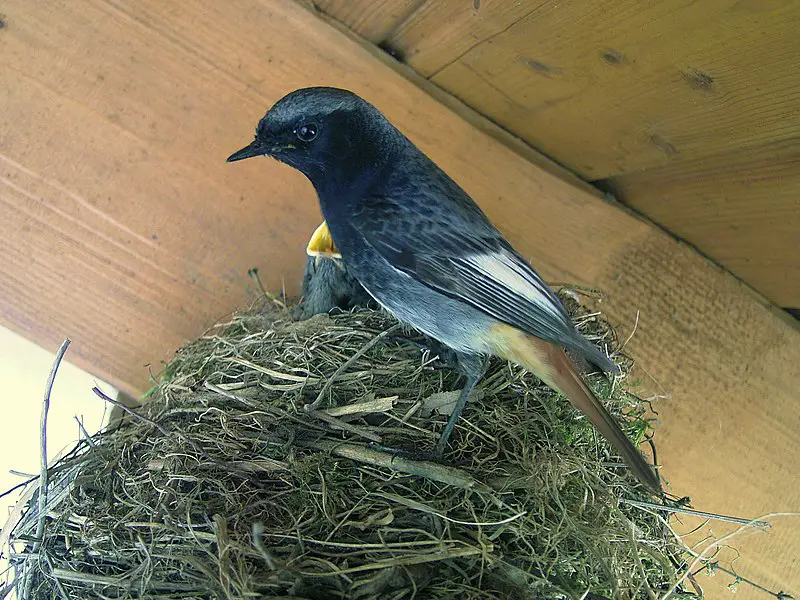
The black redstart is a small passerine bird found in the genus Phoenicurus. It was previously classified as part of the thrush family but now belongs to the Old World flycatcher family.
It has an overall black coloration with striking patches of bright orange or rusty-red on its wings and tail, giving it its name “black redstart”.
The male also sports a prominent crest which he can raise when displaying for females during breeding season.
This species inhabits open woodland areas and generally feeds on insects such as flies, beetles, spiders and caterpillars; although they will supplement their diet with berries where available.
They are often seen perched very prominently from exposed branches near food sources like hedgerows or tree stumps making them easier to spot than some other birds of similar size .
Scientific classification:
| Kingdom | Animalia |
| Phylum | Chordata |
| Class | Aves |
| Order | Passeriformes |
| Family | Muscicapidae |
| Genus | Phoenicurus |
| Species | P. ochruros |
Also Featured In: Common Birds in the Cities, Common Cornwall Birds
14. Common Buzzard
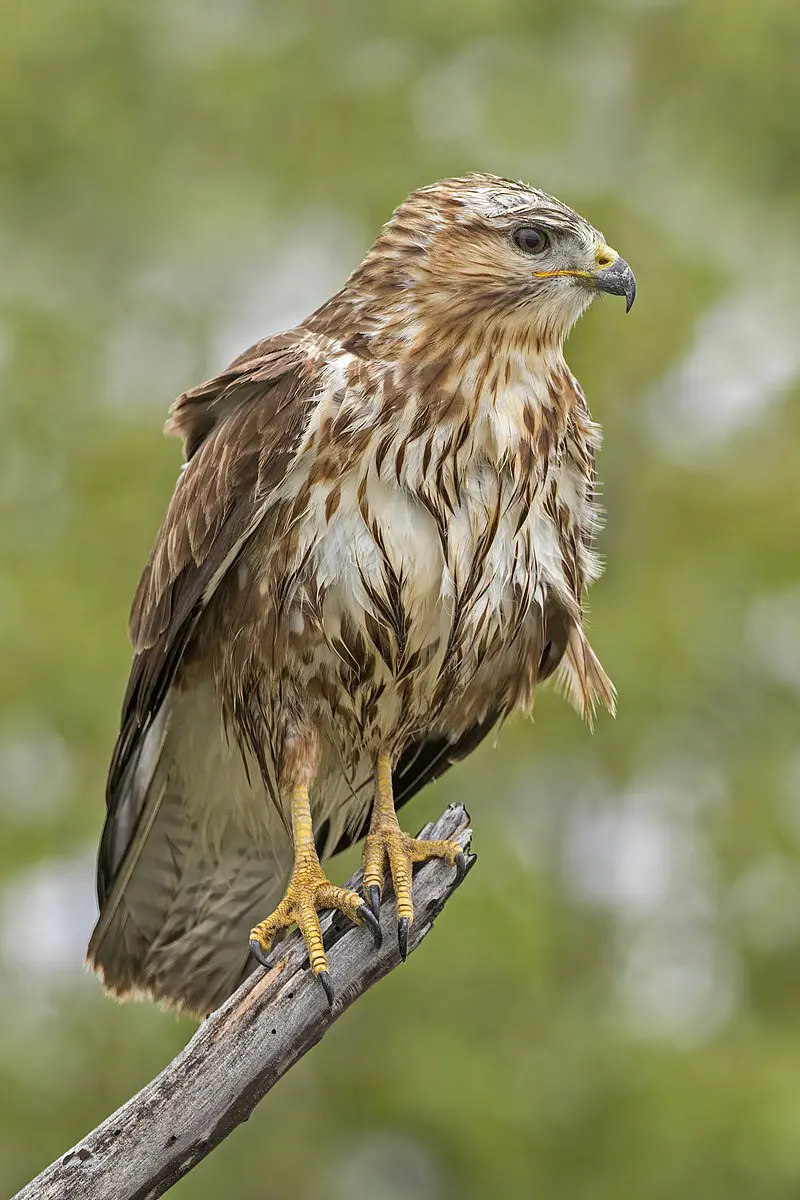
The common buzzard is a large bird of prey found across much of Europe, the Palearctic region and parts of Asia. This species has medium to dark brown plumage with lighter streaks on its body.
It has broad wings which are useful for soaring high in search of food such as small rodents, lizards, amphibians and insects.
Buzzards often hunt from a perch or while hovering above open areas like fields and meadows where they can easily spot their prey below.
They also take advantage of thermals rising up from warm ground during hot summer days to gain altitude without expending energy flapping their wings.
In addition to hunting alone, these birds will sometimes join forces with others when scavenging carrion or chasing away predators that threaten their nests full of eggs or young chicks .
Scientific classification:
| Kingdom | Animalia |
| Phylum | Chordata |
| Class | Aves |
| Order | Accipitriformes |
| Family | Accipitridae |
| Genus | Buteo |
| Species | B. buteo |
Also Featured In: European Birds, Most Common Scotland Birds
15. Yellow-Billed Stork
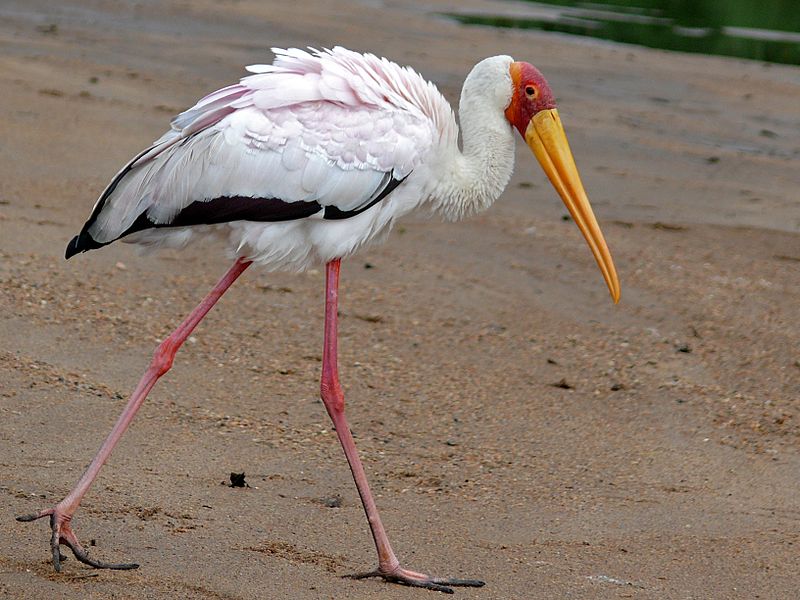
The yellow-billed stork is a large wading bird found in Africa south of the Sahara as well as Madagascar.
It belongs to the family Ciconiidae and has three other species in its genus – Mycteria americana, Mycteria cinerea and Leptoptilos javanicus.
This majestic bird stands at an average height of up to 1 meter with a wingspan that can reach 2 meters wide.
Its plumage is predominantly white with black flight feathers that contrast against its bright yellow bill for which it is named after.
The Yellow-billed Stork feeds on fish, frogs, insects and small reptiles like snakes by probing deep into mud or shallow water bodies using its long beak.
These captivating birds are also known to form colonies during their nesting season from August until October where they build nests out of sticks atop tall trees near wetlands or riversides.
Scientific classification:
| Kingdom | Animalia |
| Phylum | Chordata |
| Class | Aves |
| Order | Ciconiiformes |
| Family | Ciconiidae |
| Genus | Mycteria |
| Species | M. ibis |
Also Featured In: Birds of Tanzania, African Birds
16. Red-Vented Bulbul
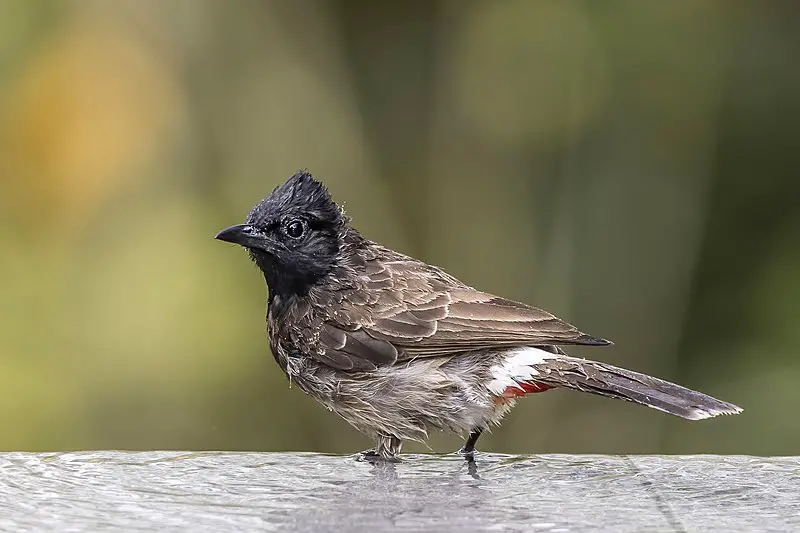
The Red-vented Bulbul is an impressive bird native to the Indian subcontinent, and has been introduced to regions around the world.
It belongs to the bulbul family of passerines and is a resident breeder in many countries including Sri Lanka, Burma, Bhutan and Nepal.
It also thrives in New Zealand, Argentina, Tonga and Fiji as well as parts of Samoa, Australia USA and Cook Islands.
This species has grey heads with white cheeks that contrast sharply against their black wings with bright red vent feathers which give them their name.
They typically live near woodland areas where they can forage for fruits or small insects on trees or bushes; this makes them useful birds for controlling insect populations naturally.
The male red-vented bulbuls are renowned songsters who sing out from treetops at dawn each day – adding some beautiful melodies to any garden.
Scientific classification:
| Kingdom | Animalia |
| Phylum | Chordata |
| Class | Aves |
| Order | Passeriformes |
| Family | Pycnonotidae |
| Genus | Pycnonotus |
| Species | P. cafer |
Also Featured In: Birds of Myanmar, Common Birds of Mumbai
17. Barbary Partridge
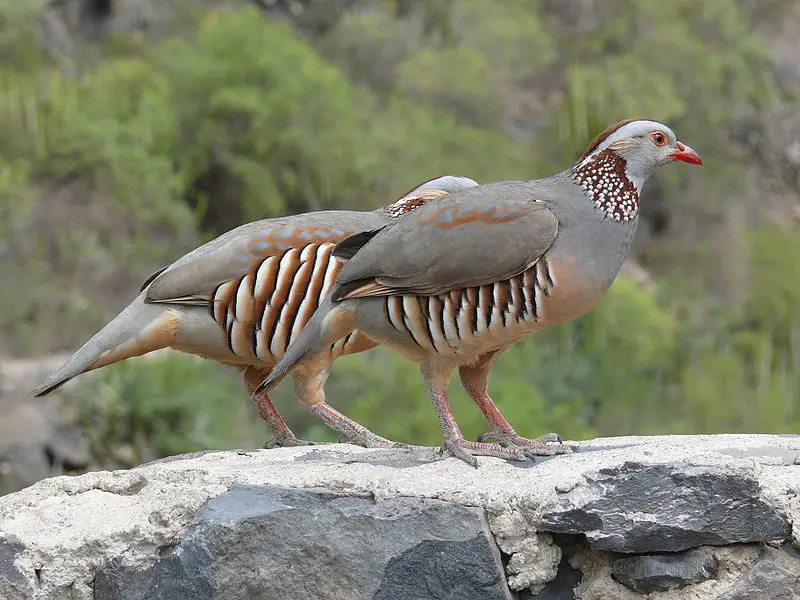
The Barbary partridge is a gamebird in the pheasant family, native to North Africa and surrounding regions such as Gibraltar and the Canary Islands.
It has been introduced to Portugal and Madeira with no recent reports of successful breeding populations outside its original range.
This species prefers open areas such as plains or scrubland, where it feeds on seeds, fruits, insects and small vertebrates like lizards. The males are larger than females with white spots on their chestnut-brown plumage.
Habitat loss due to overgrazing by livestock coupled with hunting pressure have caused declines in population numbers across much of their range making them vulnerable to local extinction if these threats continue unchecked.
Conservation measures are needed for this beautiful bird’s long-term survival.
Scientific classification:
| Kingdom | Animalia |
| Phylum | Chordata |
| Class | Aves |
| Order | Galliformes |
| Family | Phasianidae |
| Genus | Alectoris |
| Species | A. barbara |
Also Featured In: Birds of Morocco,
18. Kentish Plover
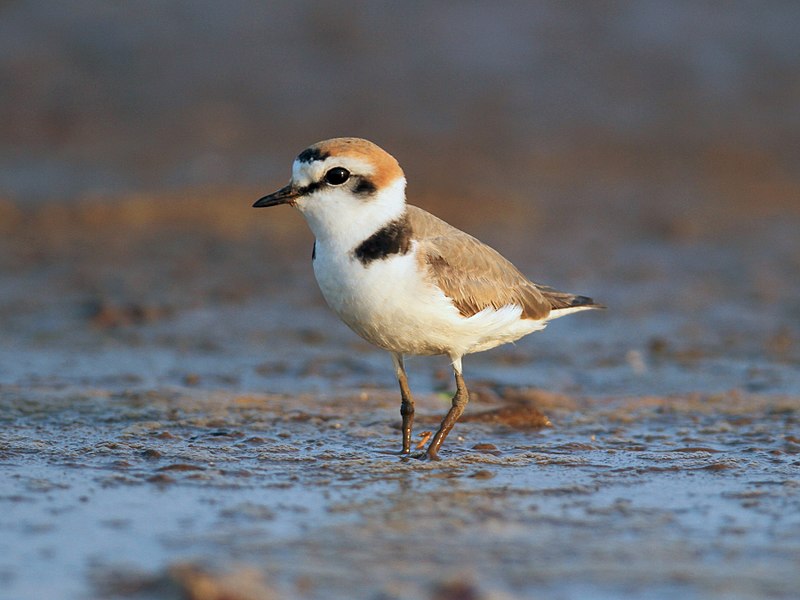
The Kentish plover is an elegant shorebird found around the world in coastal areas, saline lakes and lagoons. Both males and females have pale plumages with a white underside, grey/brown back, dark legs and a black bill.
The male birds however feature one extra distinction; they sport chestnut crowns on their heads.
During mating season the males are known to perform elaborate courtship displays – flying up high into the air before diving rapidly towards its partner while singing loudly.
They can be seen nesting among rocks or sand dunes close to water bodies where they use broken shells as building material for their nests.
This species of bird provides many benefits including controlling insect populations near coasts as well as providing food sources for larger predators such as raptors during migration times when prey is scarce.
Scientific classification:
| Kingdom | Animalia |
| Phylum | Chordata |
| Class | Aves |
| Order | Charadriiformes |
| Family | Charadriidae |
| Genus | Charadrius |
| Species | C. alexandrinus |
Also Featured In: Birds in Sri Lanka, Birds Found in Hungary
19. Sandwich Tern
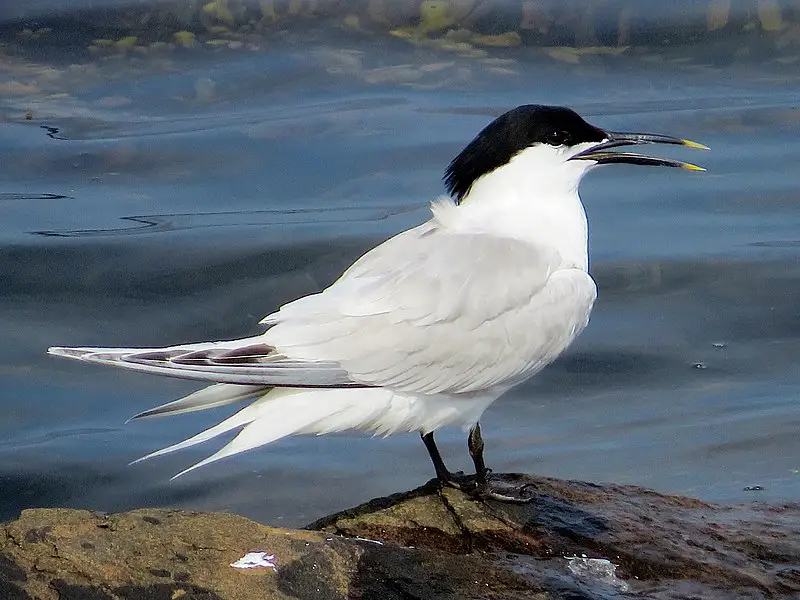
The Sandwich Tern is a medium-sized tern species belonging to the family Laridae. It has close relationships with four other crested terns, and is known to interbreed with the lesser crested.
These birds are distributed throughout Europe and as far east as Caspian Sea in summer, while they migrate south during winter season up to South Africa and India.
They have long wings which help them fly over vast distances effortlessly.
The plumage of these birds consists mainly of greyish tones on its body combined with white head and neck area; whereas it also sports an orange beak along black markings near their eyes – giving them a distinct look from other related species.
Scientific classification:
| Kingdom | Animalia |
| Phylum | Chordata |
| Class | Aves |
| Order | Charadriiformes |
| Family | Laridae |
| Genus | Thalasseus |
| Species | T. sandvicensis |
Also Featured In: Birds of Netherlands, Birds of Farne Islands
20. Ruddy Turnstone
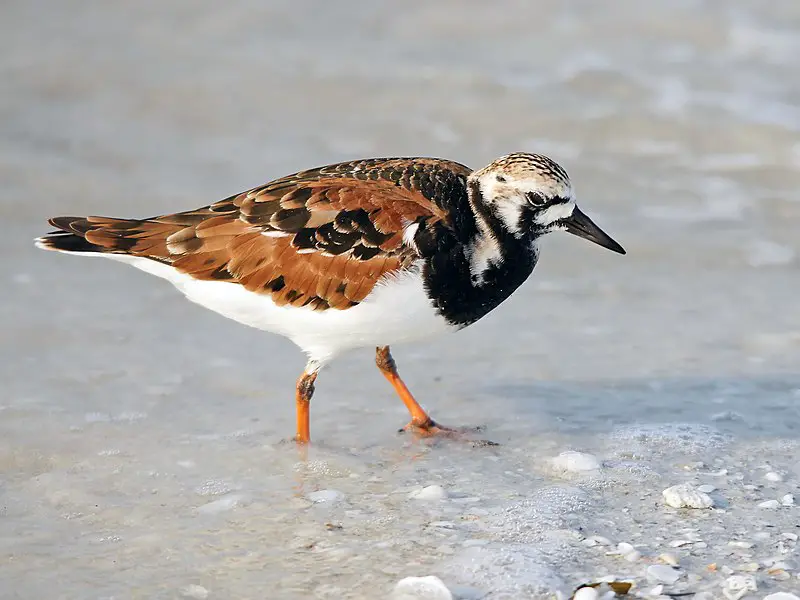
The Ruddy Turnstone is a small wading bird, belonging to the sandpiper family Scolopacidae. It has an attractive reddish-brown coloration and black patches on its back and wings.
This species breeds in northern parts of Eurasia and North America during summertime before migrating southwards in winter season to coastlines all over the world.
The Ruddy Turnstone feeds mainly on insects, mollusks, crustaceans, worms and some plant material such as seeds or berries which it finds by probing into mudflats with its bill.
It also uses stones for turning them when searching for food under rocks or pebbles along shorelines where they can often be seen darting around looking very busy.
Scientific classification:
| Kingdom | Animalia |
| Phylum | Chordata |
| Class | Aves |
| Order | Charadriiformes |
| Family | Scolopacidae |
| Genus | Arenaria |
| Species | A. interpres |
Also Featured In: Galapagos Birds You Should Know, Hawaii Big Island Birds You Should Know
21. Black-Winged Stilt
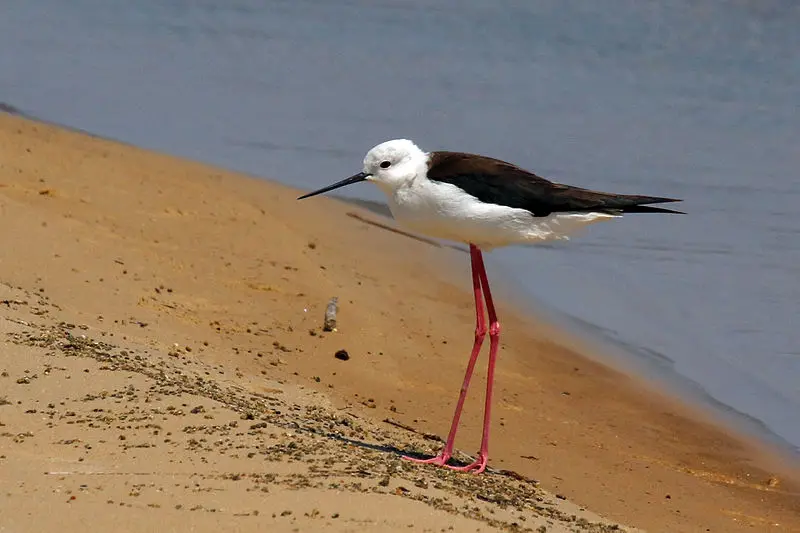
The Black-winged Stilt is a wading bird that belongs to the avocet and stilt family. It has very long legs, making it well adapted for standing in shallow water while searching for food like small fish and insects.
Its scientific name Himantopus himantopus can be applied either to one cosmopolitan species or the form found across Europe, Asia and Africa which equals its nominate group.
Generally this species is black on top with an all white underside but it also features red eyes with a thin white ring around each one as well as black wings flecked with white feathers towards the tips of their wings.
Scientific classification:
| Kingdom | Animalia |
| Phylum | Chordata |
| Class | Aves |
| Order | Charadriiformes |
| Family | Recurvirostridae |
| Genus | Himantopus |
| Species | H. himantopus |
Also Featured In: Birds of Senegal, Ukrainian Birds You Should Know
22. Northern Gannet
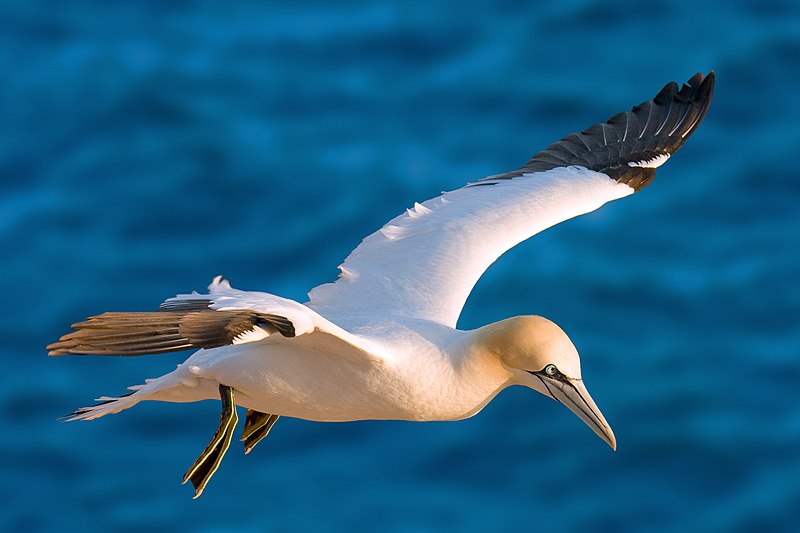
The Northern Gannet is the largest species of seabird in the northern Atlantic, with a white body and long neck.
It has yellowish head feathers and black tipped wings that can reach up to 6 feet across when fully extended.
The beak is large and orange-yellow in color. This bird breeds along western Europe’s coasts as well as northeastern North America.
They forage for fish by plunging into the sea from high above, making them an impressive sight to behold on any given day.
Their diet consists mainly of herring, mackerels or sand eels which they catch midair after diving at speeds reaching over 100 miles per hour.
With their striking features these birds are truly majestic creatures that have been around since prehistoric times – a testament to their hardiness and adaptability.
Scientific classification:
| Kingdom | Animalia |
| Phylum | Chordata |
| Class | Aves |
| Order | Suliformes |
| Family | Sulidae |
| Genus | Morus |
| Species | M. bassanus |
Also Featured In: Birds found in portugal, Italian Birds You Should Know
23. Black-Bellied Sandgrouse
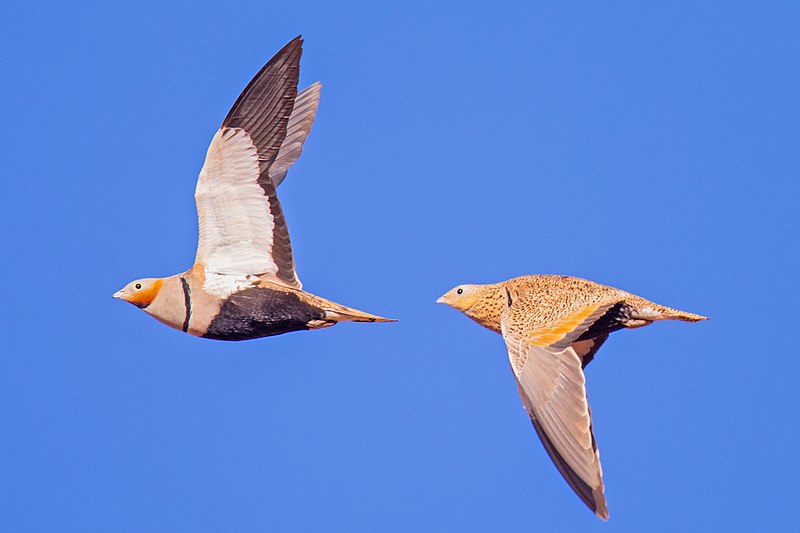
The Black-bellied sandgrouse is a species of medium large bird in the family Pteroclididae. It breeds across Iberia, northwest Africa, Turkey, Iran and Israel as well as on the Canary Islands and Cyprus.
The eastern form of this species can be found in Kazakhstan, western China and northern Pakistan where it migrates seasonally from central Asia.
This ground dwelling bird has greyish – brown plumage with barred underparts while its belly is black which gives it its name ‘Black-bellied Sandgrouse’.
Its diet consists mainly of seeds picked up on open dry groud or short vegetation close to water sources.
Scientific classification:
| Kingdom | Animalia |
| Phylum | Chordata |
| Class | Aves |
| Order | Pterocliformes |
| Family | Pteroclidae |
| Genus | Pterocles |
| Species | P. orientalis |
Also Featured In: Kyrgyzstan Birds,
24. Eurasian Whimbrel
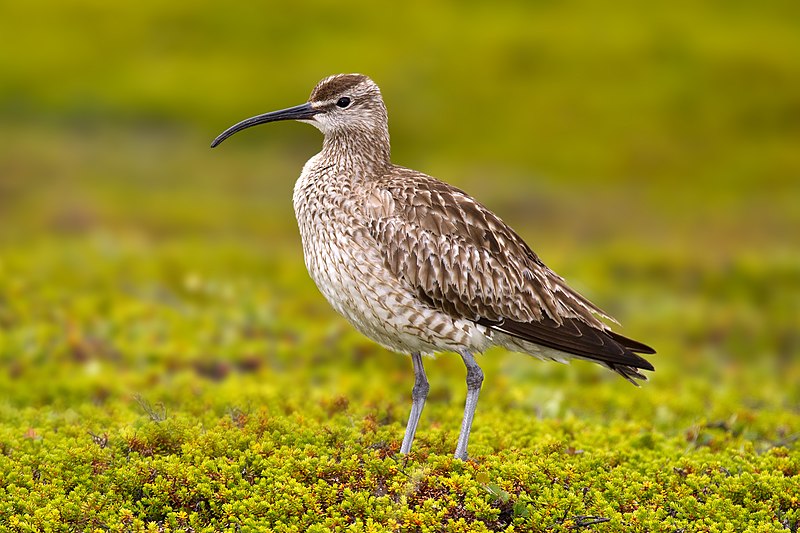
Eurasian Whimbrels are a species of wading bird commonly found in subarctic regions of Europe and Asia.
They have white rumps, long curved bills, brown wings and backs with light streaking on the lower breast.
These birds feed mainly on crustaceans, mollusks or worms they find while probing in the mud during low tide.
During breeding season they can be seen nesting near coastal areas or wetlands where food is plentiful.
This species has recently been split from Hudsonian whimbrels but some authorities still consider them to be one species due to their similarities which includes migration patterns as well as habitat preferences.
Eurasian whimbrels are an important part of many ecosystems because they help control insect populations by eating larvae before it can cause damage to crops or vegetation nearby.
Scientific classification:
| Kingdom | Animalia |
| Phylum | Chordata |
| Class | Aves |
| Order | Charadriiformes |
| Family | Scolopacidae |
| Genus | Numenius |
| Species | N. phaeopus |
Also Featured In: Singapore Birds, Birds that Live in San Francisco Bay Area
25. Ruddy Shelduck
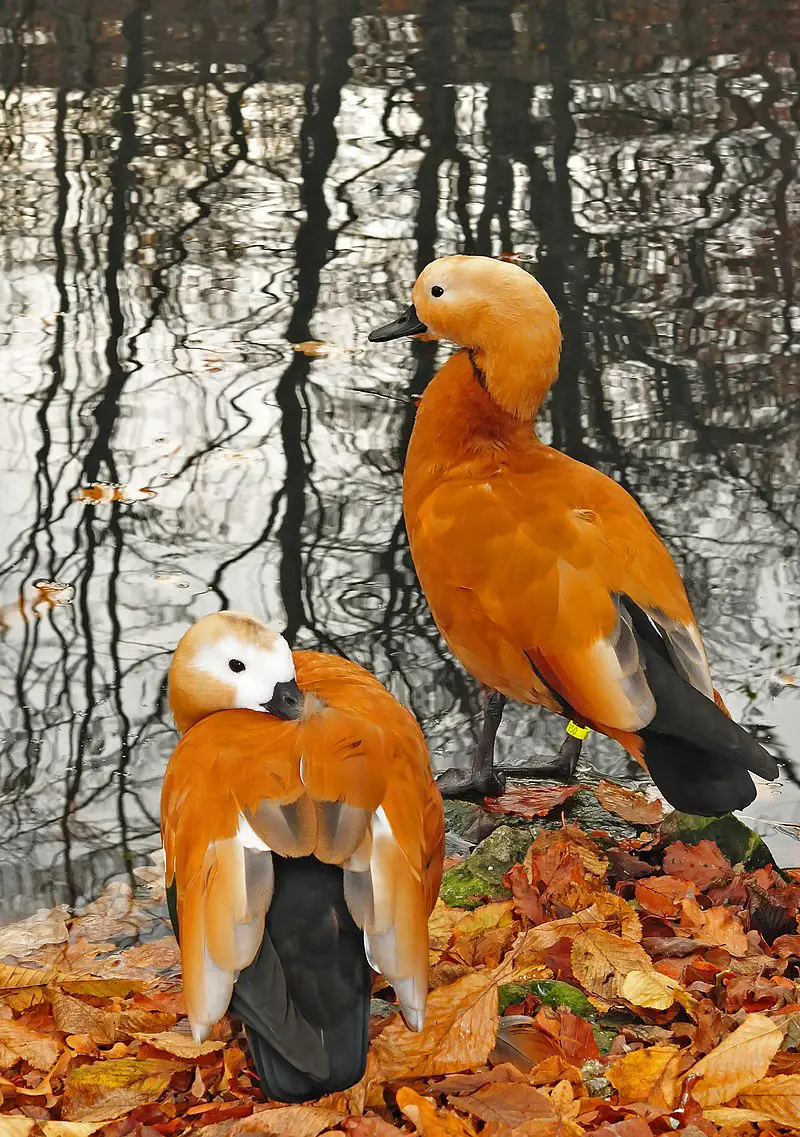
The Ruddy Shelduck is a unique and vibrant waterfowl, easily recognizable due to its orange-brown body plumage with a paler head.
It measures between 58 cm – 70 cm in length and its wingspan ranges from 110 cm – 135cm.
Its tail feathers along with the flight feathers are black in colour, standing out against the white wing coverts.
This bird can be found throughout Europe, Asia and Africa as it migrates regularly during certain times of year.
Its diet consists mainly of plant material such as roots & tubers; however they do occasionally eat small insects or molluscs for extra nutrition when available.
The Ruddy Shelduck makes an interesting addition to any aviary.
Scientific classification:
| Kingdom | Animalia |
| Phylum | Chordata |
| Class | Aves |
| Order | Anseriformes |
| Family | Anatidae |
| Genus | Tadorna |
| Species | T. ferruginea |
Also Featured In: Kuwait Birds, Moscow Birds You Need to See
26. Spanish Sparrow
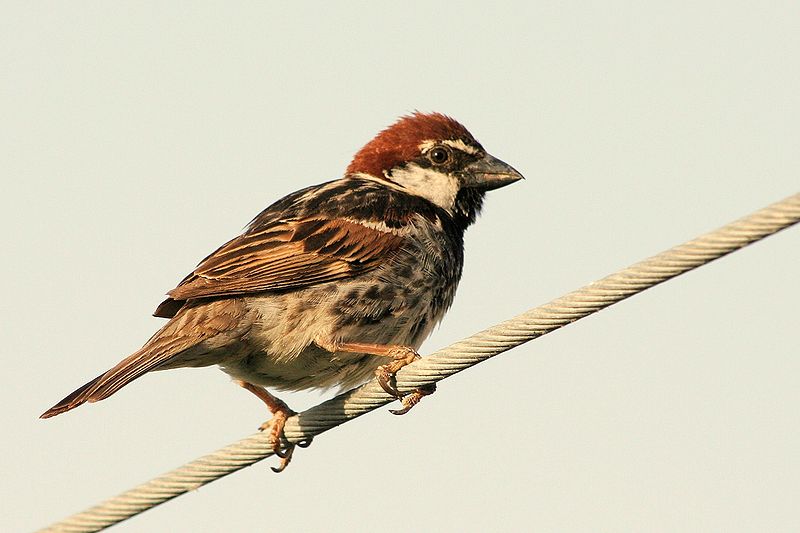
The Spanish sparrow or willow sparrow (Passer hispaniolensis) is a beautiful member of the passerine bird family Passeridae, found mainly in the Mediterranean region and south-west and central Asia.
With its striking colouration – having chestnut brown upperparts with black streaks on its back and wings, white underparts with greyish sidesand a distinctive black line running down either side of its head – it can easily be distinguished from other species.
It shares many physical characteristics with the closely related house sparrow but has some subtle differences such as being slightly smaller in size.
In addition to being an attractive species, they are also very sociable birds often nesting together in colonies making them easy to observe by birdwatchers alike.
Unfortunately hybridisation between these two species complicates their taxonomy which needs further research for clarification.
Scientific classification:
| Kingdom | Animalia |
| Phylum | Chordata |
| Class | Aves |
| Order | Passeriformes |
| Family | Passeridae |
| Genus | Passer |
| Species | P. hispaniolensis |
Also Featured In: Bahrain birds, Birds that Live in Croatia
27. Spectacled Warbler
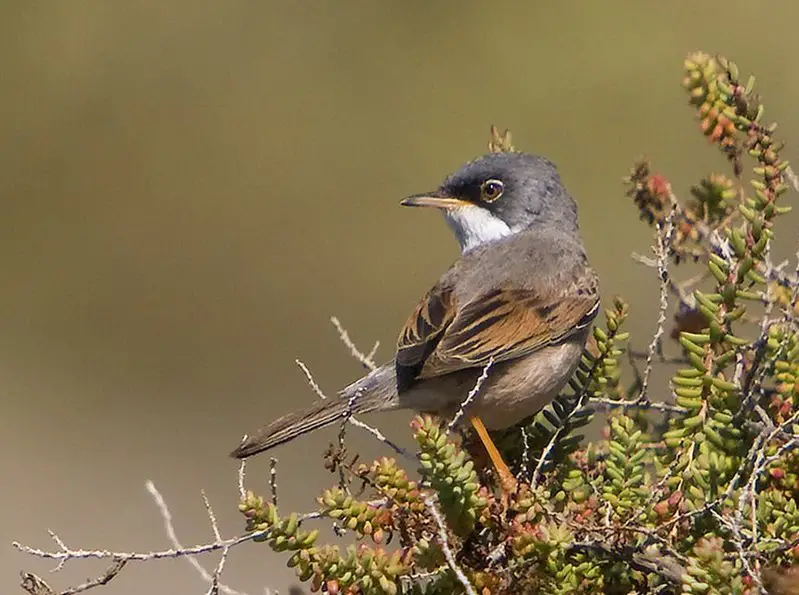
The Spectacled Warbler is a unique species of songbird found across northwest Africa, southwest Europe and the eastern Mediterranean.
It is named for its distinctive black spectacles around the eyes that give it an especially distinct appearance.
The bird has mainly brown-grey plumage with yellowish underparts, making them easy to identify in their natural habitats which include open woodlands and scrubby areas near rivers and coasts.
They typically feed on insects such as flies or caterpillars but will also consume fruit during times when food sources are scarce.
As they tend to be non-migratory birds they remain in their chosen habitat all year round providing much needed insect control services throughout different seasons.
Scientific classification:
| Kingdom | Animalia |
| Phylum | Chordata |
| Class | Aves |
| Order | Passeriformes |
| Family | Sylviidae |
| Genus | Curruca |
| Species | C. conspicillata |
Also Featured In: Cabo Verde birds,
28. Scopoli’s Shearwater
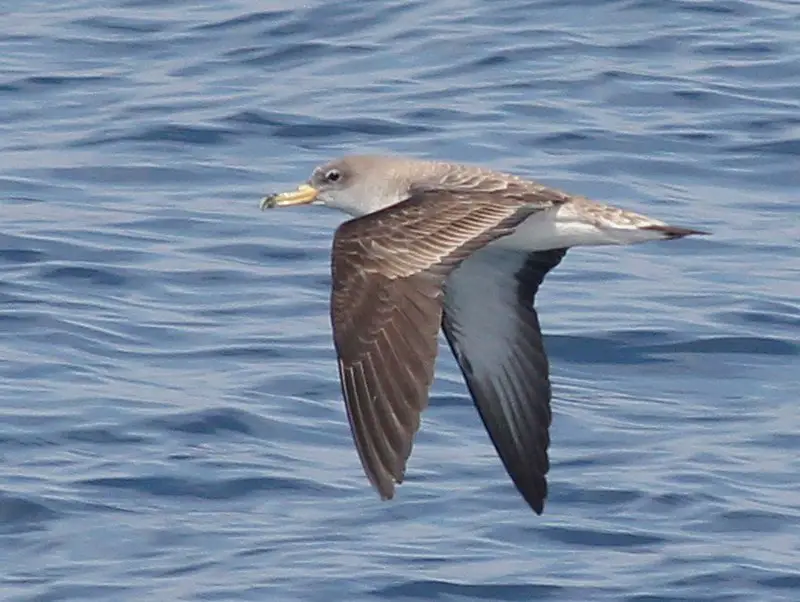
Scopoli’s shearwater is a seabird in the petrel family Procellariidae which breeds on rocky islands and steep coasts in the Mediterranean.
It has brownish grey feathers above, with darker wings and mostly white below.
Its bill is pale yellow with a dark patch near its tip, making it easily distinguishable from other birds of its kind.
The sexes are similarly coloured and were previously thought to be identical species until further inspection revealed otherwise.
During breeding season it stays close to shore but during migratory periods can often be seen searching for food far out at sea where they use their long slender bodies to glide over waves effortlessly as if flying through air.
Scientific classification:
| Kingdom | Animalia |
| Phylum | Chordata |
| Class | Aves |
| Order | Procellariiformes |
| Family | Procellariidae |
| Genus | Calonectris |
| Species | C. diomedea |
Also Featured In: Malta birds,
29. Barbary Falcon
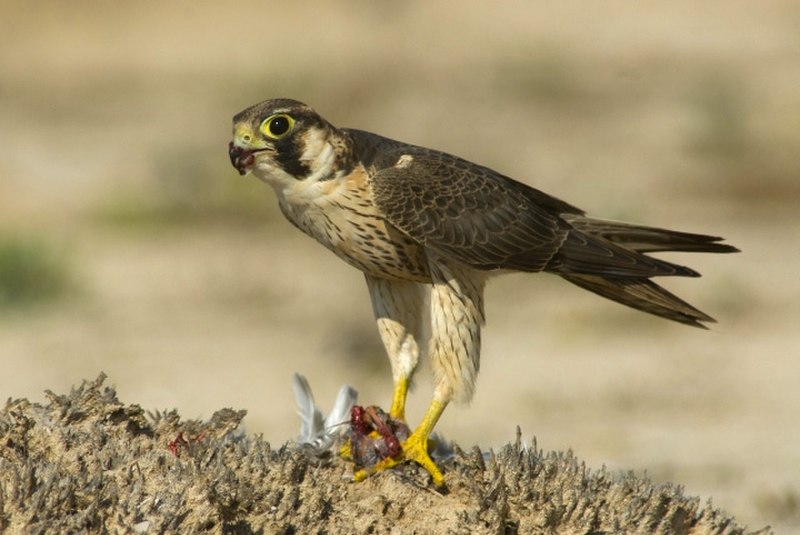
The Barbary falcon (Falco peregrinus pelegrinoides) is a medium-sized bird of prey typically found in semi-desert and dry open hills.
This agile hunter has the size of a crow, with an impressive wingspan that enables it to soar through the skies with great speed.
It mainly resides in areas ranging from the Canary Islands eastwards across North Africa, Middle East and Central Asia, usually nesting on cliff ledges or other high places.
Its diet consists mostly of small birds like pigeons or doves; however they also feed on small mammals such as bats and rodents too.
With its remarkable flying abilities and hunting prowess this majestic species continues to captivate people throughout its range making it an iconic symbol for many cultures over centuries now.
Scientific classification:
| Kingdom | Animalia |
| Phylum | Chordata |
| Class | Aves |
| Order | Falconiformes |
| Family | Falconidae |
| Genus | Falco |
| Species | F. peregrinus |
| Subspecies | F. p. pelegrinoides |
Also Featured In: Falcons Species, Birds of Lanzarote
30. Plain Swift
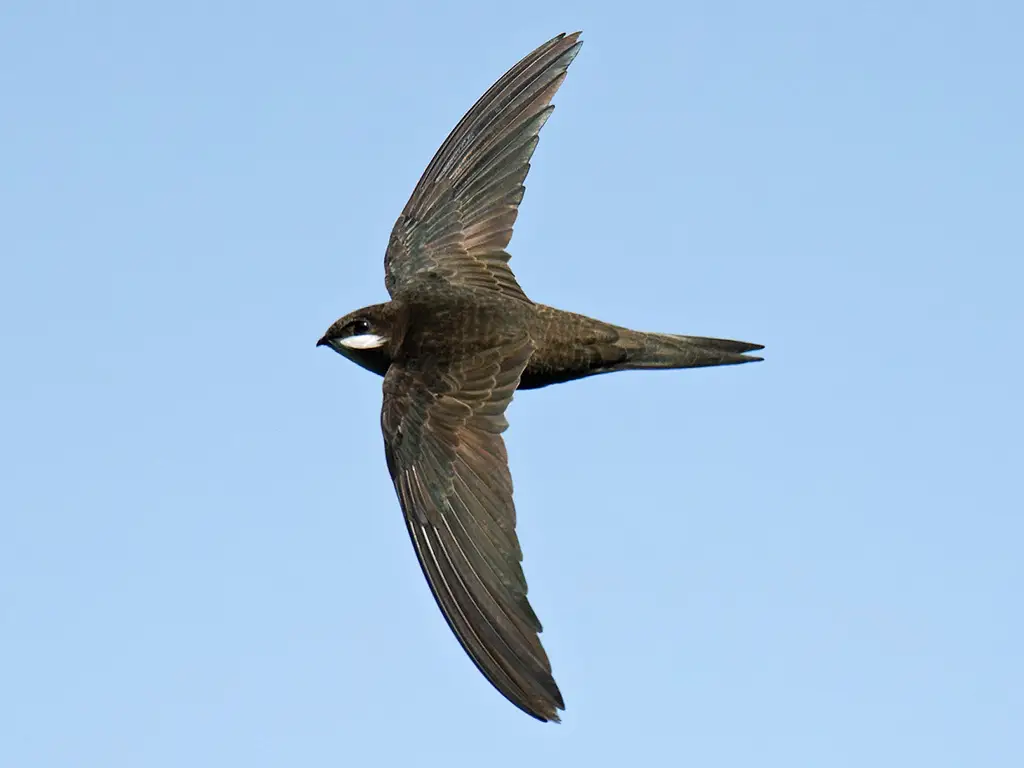
The Plain Swift (Apus unicolor) is a medium-sized bird belonging to the swift family.
With its short legs and long, slender wingspan, it closely resembles a Barn Swallow or House Martin but actually isn’t related to them at all
Instead this similarity between species from different families has come about through convergent evolution – both types of birds have adapted to similar lifestyles.
They spend most of their lives in flight, only rarely landing on vertical surfaces like cliffsides where they can cling with their feet for support.
Their diet consists mainly of airborne insects which they catch while flying so rapidly that even other swifts cannot keep up.
This speedy lifestyle makes them difficult to study and observe as they are often gone before you’ve had time to take notice.
Scientific classification:
| Kingdom | Animalia |
| Phylum | Chordata |
| Class | Aves |
| Order | Apodiformes |
| Family | Apodidae |
| Genus | Apus |
| Species | A. unicolor |
Also Featured In: Swifts Species,
31. Berthelot’s Pipit
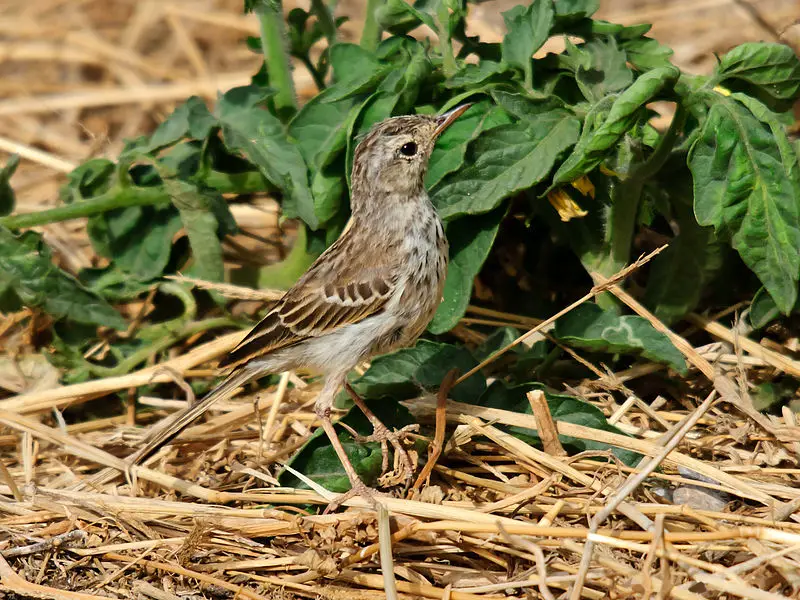
Berthelot’s pipit is a small bird that can be found in the Canary Islands and Madeira. It prefers open areas for nesting and lays 3-5 eggs on the ground.
The bird is mainly gray above, and it’s an inconspicuous-looking species on the ground. It’s a common resident in both archipelagos, and it’s about 13-14 centimeters long.
Known as a pipit, it belongs to the passerine family. Despite looking unremarkable, it’s considered a beautiful bird and is highly appreciated by birdwatchers for its delicate features, simple melodies, and unassuming nature.
Berthelot’s pipit is a species that is well-loved across the Canary Islands and Madeira.
Scientific classification:
| Kingdom | Animalia |
| Phylum | Chordata |
| Class | Aves |
| Order | Passeriformes |
| Family | Motacillidae |
| Genus | Anthus |
| Species | A. berthelotii |
Also Featured In: Birds of Gran Canaria Island,
32. Cory’s Shearwater
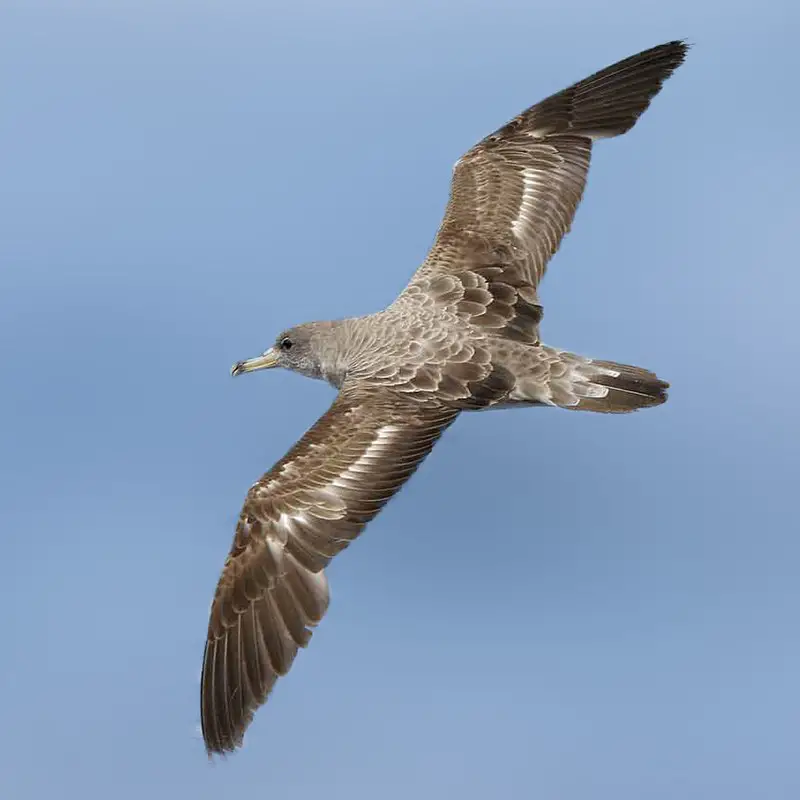
The Cory’s shearwater is a seabird from the Procellariidae family that lives in the eastern Atlantic. It breeds in colonies in rocky islands and has a wide range during the non-breeding season.
The bird was described by Charles B. Cory in 1881 and is larger in size compared to other shearwaters. It was previously classified as Scopoli’s shearwater but was later recognized as a distinct species.
Known for its long, slender wings, the Cory’s shearwater is adapted for long-distance flight and can cover great distances while foraging for food.
The bird’s plumage is mostly brown and gray with a white belly, and it has a sharply pointed beak that aids in catching prey.
The Cory’s shearwater is an important part of marine ecosystems and helps to control populations of fish and squid.
Scientific classification:
| Kingdom | Animalia |
| Phylum | Chordata |
| Class | Aves |
| Order | Procellariiformes |
| Family | Procellariidae |
| Genus | Calonectris |
| Species | C. borealis |
Also Featured In: Birds that Live in the Ocean , Most Common Birds of San Miguel Island
33. Sardinian Warbler
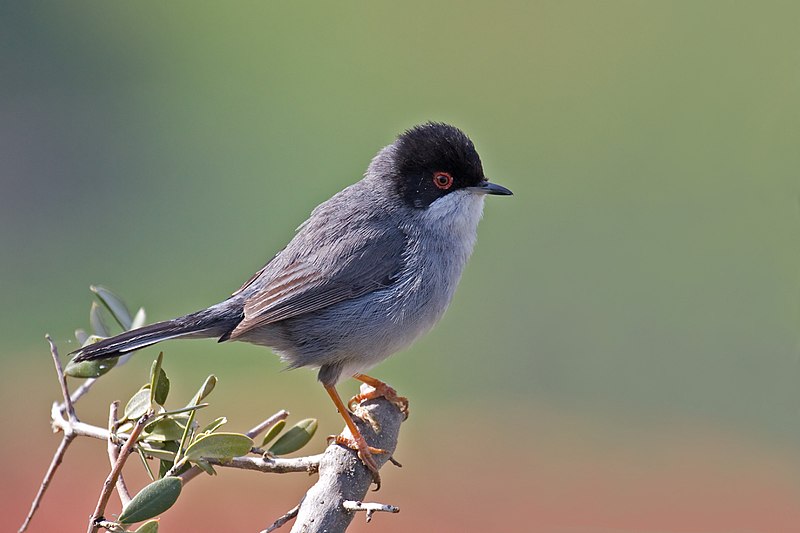
The Sardinian warbler is a species of typical warbler commonly found in the Mediterranean region. This bird has distinctive male and female plumages. The male has a black head, grey back, and whitish underparts, along with a white throat and striking red eyes.
The female has similar colors but with a brownish hue. There can be some variation in plumage even in the same area, with some birds having reddish upper- and/or undersides.
These birds are known for their lively and musical songs, performed both during breeding season and for territorial purposes.
Sardinian warblers are frequently found in scrubby habitats, including maquis and garrigue, where they feed on insects and other small invertebrates.
Despite their relatively common status, these birds are still vulnerable to threats such as habitat loss and predation by invasive species.
Scientific classification:
| Kingdom | Animalia |
| Phylum | Chordata |
| Class | Aves |
| Order | Passeriformes |
| Family | Sylviidae |
| Genus | Curruca |
| Species | C. melanocephala |
Also Featured In: Most Common Birds of Sardinia, Most Popular Birds in Mallorca
34. Hadada Ibis
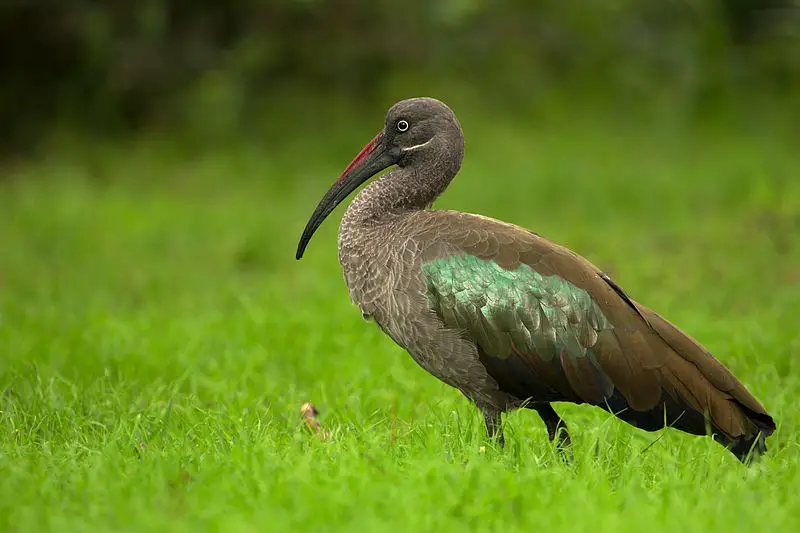
The Hadada ibis, native to Sub-Saharan Africa, is a loud and distinctive bird known for its three to four note calls during flight.
Often found near wetlands, they are adaptable and can also forage in cultivated land and gardens, often in close proximity to humans.
Unlike some other ibises, they are not entirely dependent on water. The Hadada ibis is named after the sound it makes and can often be heard in the early mornings and evenings as they fly out or return to their roosts.
With their sleek feathers and elongated beaks, they are a unique and interesting addition to the diverse wildlife of Africa.
Scientific classification:
| Kingdom | Animalia |
| Phylum | Chordata |
| Class | Aves |
| Order | Pelecaniformes |
| Family | Threskiornithidae |
| Genus | Bostrychia |
| Species | B. hagedash |
Also Featured In: Birds You’ll Find in Kenya Safari, Birds of KwaZulu-Natal
35. Trumpeter Finch
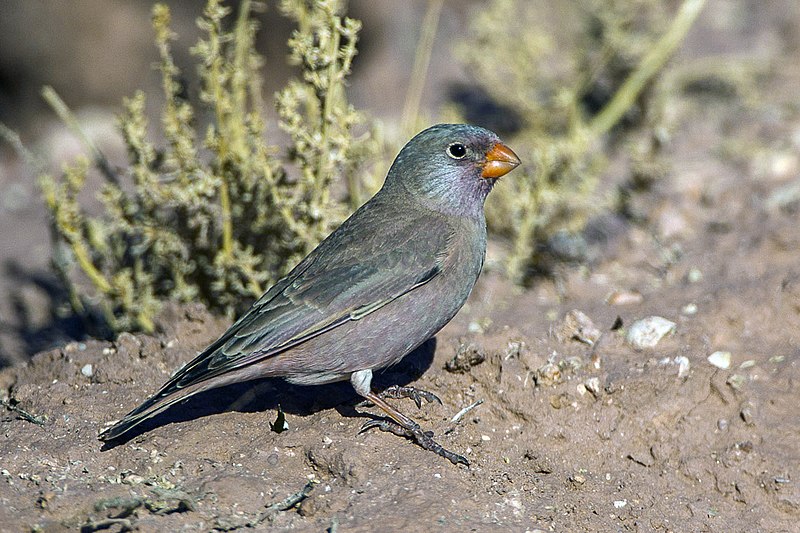
The Trumpeter Finch, also known as Bucanetes githagineus, is a small bird that belongs to the finch family Fringillidae.
This bird species is commonly found in regions with a desert climate such as North Africa, Spain, and southern Asia, and they can be spotted as vagrants in areas outside their breeding range.
The bird is mainly brown and white in color, and it has a unique call that sounds like a trumpet, hence the name.
The Trumpeter Finch can breed from the Canary Islands going eastward across North Africa, and it can be spotted in countries such as Mauritania, Mali, and Chad.
These birds are adapted to dry climates and can be seen perched on rocky outcrops, feeding on seeds and insects.
Scientific classification:
| Kingdom | Animalia |
| Phylum | Chordata |
| Class | Aves |
| Order | Passeriformes |
| Family | Fringillidae |
| Subfamily | Carduelinae |
| Genus | Bucanetes |
| Species | B. githagineus |
36. Iberian Grey Shrike
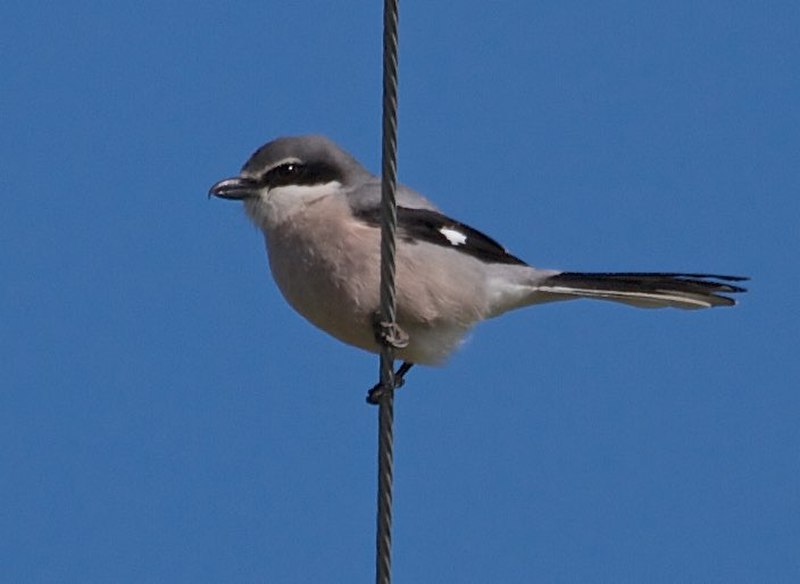
The Iberian grey shrike is a bird belonging to the shrike family. It appears quite similar to the great grey shrike species except for a few distinctive features.
It was once thought to be the same species as the latter but was later identified as a distinct one. Interestingly, these two species do not breed with each other and are separated by their different habitats.
The Iberian grey shrike is typically found in the Iberian Peninsula and certain parts of North Africa. Its diet primarily consists of insects and small vertebrates.
It is also known for its unique hunting behavior where it impales its prey on sharp objects such as thorns before consuming them later.
Overall, the Iberian grey shrike is a fascinating bird that has adapted to its environment and gained its place in the diverse family of shrikes.
Scientific classification:
| Kingdom | Animalia |
| Phylum | Chordata |
| Class | Aves |
| Order | Passeriformes |
| Family | Laniidae |
| Genus | Lanius |
| Species | L. meridionalis |
Also Featured In: Most Common Spain Birds,
37. Mediterranean Short-Toed Lark
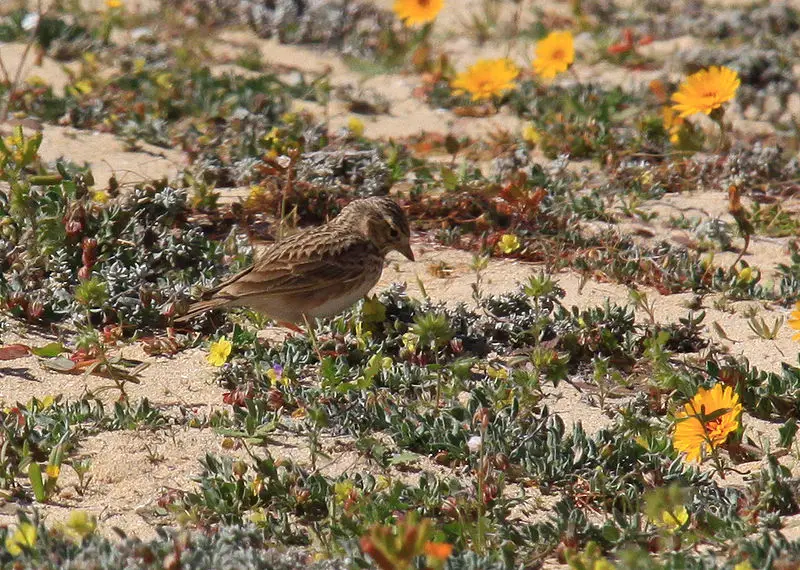
The tiny Mediterranean short-toed lark is a passerine bird native to the Mediterranean Basin. These birds are widespread, from the Canary Islands up to the Iberian Peninsula and spanning across North Africa to parts of the Middle East.
Their conservation status is of “least concern,” according to the International Union for Conservation of Nature.
Despite its small size, the Mediterranean short-toed lark is a common bird found in a variety of habitats, including steppe, desert, and agricultural fields.
They have brownish-grey feathers with streaks of black and white, and a small crest on their heads.
These little larks are known for their unique flight patterns, which include a jumpy and erratic flight with brief hovering.
Overall, the Mediterranean short-toed lark is a lively and common bird found throughout the Mediterranean Basin.
Scientific classification:
| Kingdom | Animalia |
| Phylum | Chordata |
| Class | Aves |
| Order | Passeriformes |
| Family | Alaudidae |
| Genus | Alaudala |
| Species | A. rufescens |
38. Fuerteventura Stonechat
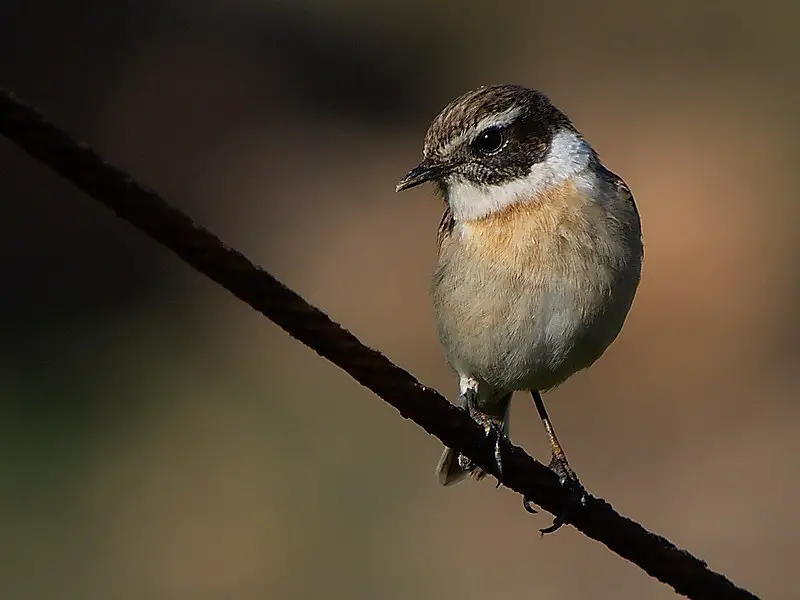
The Fuerteventura Stonechat, also known as the Caldereta, is a small bird found only on the island of Fuerteventura in the Canary Islands.
While it was once widespread throughout the canary islands, it is now a sedentary resident bird only found on this one island.
This bird is also known as the Saxicola dacotiae and was previously called the Canary Islands Chat.
As a passerine bird, it is a part of the order Passeriformes, which includes more than half of all bird species.
Despite its small size, this bird is known for its distinctive appearance and lively personality.
While it may not be easy to spot, the Fuerteventura Stonechat is an important part of the unique birdlife found on the island of Fuerteventura.
Scientific classification:
| Kingdom | Animalia |
| Phylum | Chordata |
| Class | Aves |
| Order | Passeriformes |
| Family | Muscicapidae |
| Genus | Saxicola |
| Species | S. dacotiae |
39. Yellow-Browed Warbler
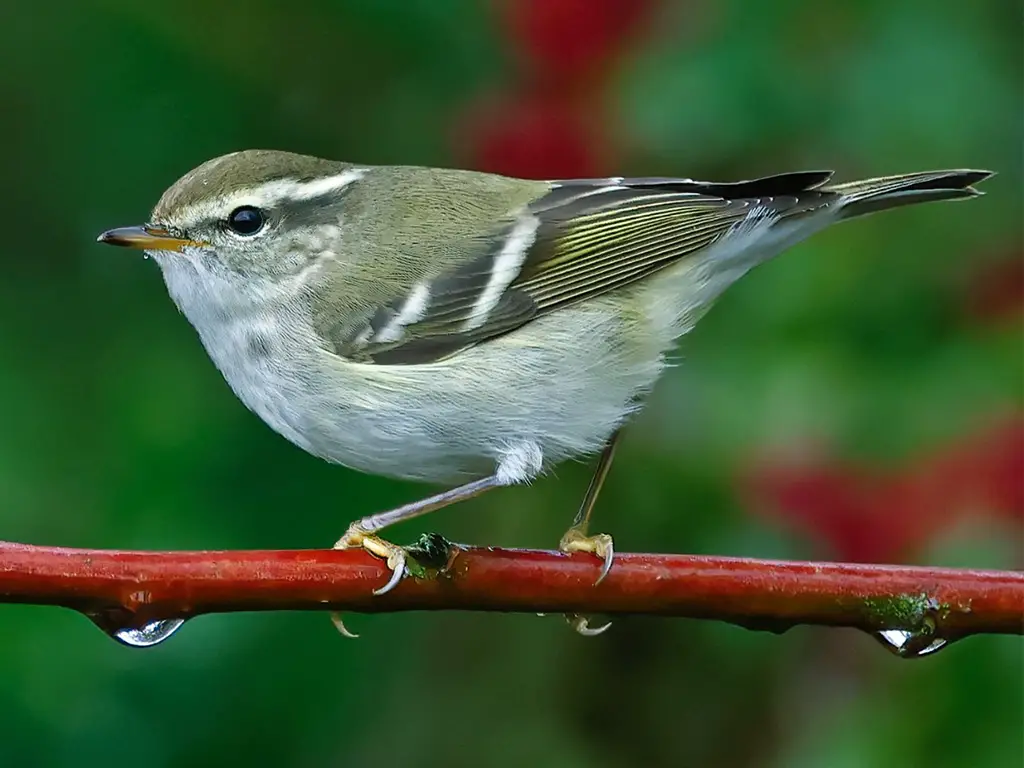
The Yellow-browed warbler is a migratory bird that breeds in eastern Palearctic and winters in South and Southeast Asia. It can also be found in small numbers in western Europe during winter.
This warbler belongs to the Phylloscopidae family and was once included in the Old World warbler group. The Yellow-browed warbler is a leaf warbler and has a distinct yellow eyebrow. It is an active bird and is known for its distinctive call.
The habitat of this bird includes coniferous and deciduous forests. These birds are known to be quite adaptable and can survive in a wide range of environments.
Despite their small size, they can cover large distances during migration, traveling thousands of miles.
Overall, the Yellow-browed warbler is a fascinating bird that is highly adaptable and capable of long-distance flight.
Scientific classification:
| Kingdom | Animalia |
| Phylum | Chordata |
| Class | Aves |
| Order | Passeriformes |
| Family | Phylloscopidae |
| Genus | Phylloscopus |
| Species | P. inornatus |
Also Featured In: Most Common Birds of Ko Samui, Ko Samet Birds You Need To Know